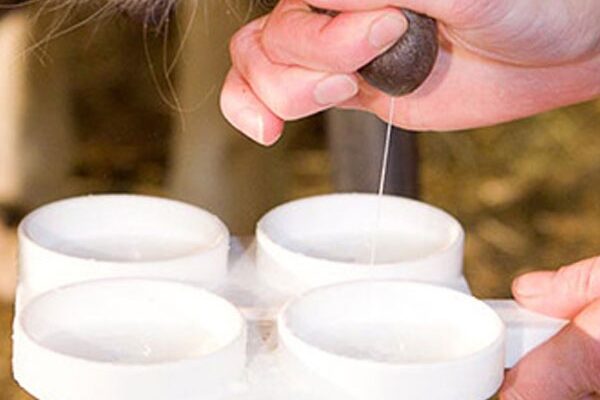The global bovine mastitis market size was valued at USD 540 million in 2021 and is projected to reach around USD 1,100 million in 2030 exhibiting a CAGR of 6.5% in the forecasted period.
The increasing incidence of bovine mastitis, growing products approval and launches by market players are anticipated to upsurge the market growth. Moreover, rising prevalence of bovine mastitis infections during the dry season, as well as the increased benefits of non-antibiotic intramammary products are projected to boost the market. However, increased antibiotic resistance and lack of awareness about the diseases are the factors hindering the growth of the market in the forecasted period.
The growth in the prevalence of bovine mastitis and the increase in the incidence of cow injury boost the growth of the bovine mastitis market. For instance, as per the research article published on August 2020, in Veterinary Medicine International, an editor of original research articles and review articles in all parts of veterinary research, the complete prevalence of mastitis described was 80% in Kenya. Bovine mastitis is mostly affected by numerous bacterial & fungal infections such as Str. agalactiae, Staphylococcus aureus, Str. zooepidemicus, Str. Pyogenes, Str. faecalis, Pasteurella multocida, and Aspergillus fumigatus.
Additionally, the growth in the number of dairy farms and boost in the construction of dairy products furl the growth of the bovine mastitis market. The upsurge in demand for dairy products and an increase in milk production fuel the growth of the bovine mastitis industry. For example, as per the United States Department of Agriculture (USDA’s) Milk Production article, the yearly milk production in the U.S. in 2020 was 223 billion pounds, growing just over 2% from the 218 billion pounds manufactured in 2019.
The COVID-19 outbreak is expected to have a negative impact on the growth of the bovine mastitis market as there is lockdown in many nations. The COVID-19 pandemic affected the supply chain for farmhouses and dairy industry. The complete healthcare industry has dedicated on life saving and COVID-19 associated products throughout the pandemic which confine the treatment of bovine mastitis. Thus, COVID-19 had substantial negative impact on bovine mastitis market. Though, the healthcare sector has been reorganized to offer harmless healthcare facilities. Later, the market is predicted to grow in post pandemic situations.
Type Insights
Based on the type, bovine mastitis is categorized into clinical mastitis and sub-clinical mastitis. As per the study published in the Journal of Molecular Diversity Preservation International (MDPI) in May 2021, the occurrence of clinical mastitis was around 9%, 10%, and 10% in cows, camels, and goats respectively, while, sub-clinical mastitis was found to be 8.6%, 4.5%, 10% in cows, camels, and goats respectively in Southern Ethiopia. The critical need for treatment of clinical mastitis, along with the accessibility of drugs, increasing awareness, is leading to a wider acceptance globally. The rise in the dairy herd size and a budding number of incidence cases of clinical mastitis in dairy cattle farms in both developed and emergent nations are the factors responsible for the projected largest share of clinical mastitis throughout the forecasted period. Though, a sub-clinical segment is anticipated to project a substantial growth rate owing to increasing awareness among cattle farmers and the need for vital treatment of sub-clinical mastitis.
Moreover, technical advancements in the field of drug discovery and development for handling clinical mastitis will fuel the segment growth. For instance, Zoettis, Inc. has joined forces with Trianni, Inc. in July 2020 for the development of transgenic monoclonal antibody platforms to determine new veterinary treatments.
The antibiotics segment also holds an important market share in the bovine mastitis global market. Antibiotics are the products used for treatment owing to the inadequate presence of other drugs, making a huge number of dairy farms prefer antibiotics for the treatment.
Route of Administration Insights
Based on the route of administration, the systemic segment dominated the bovine mastitis market in 2021, and this trend is anticipated to continue throughout the forecast period, due to the rising prevalence of bovine mastitis and the upsurge in animal welfare funding.
Though, the intramammary segment is projected to witness significant growth through the forecasted period, owing to an upsurge in the prevalence of bovine mastitis and a growth in R&D activities for the expansion of advanced treatment.
Region Insights
The United States is the most COVID-affected country around the globe. COVID-19 has negligible impact on the bovine mastitis market as they fall in the essential service category. Though, there were some manufacturing closures owing to the social distancing and lockdowns through the country.
North America is found to grasp a major share of the bovine mastitis market, and it is anticipated to show a comparable trend over the projected period, without important fluctuations owing to the strong acceptance of intra-mammary infusion products for the cure and presence of prominent players in the area giving a wide range of products for the control of the contamination. The existence of large-scale initiatives in North America will not only aid the regional market growth but will also have an influence on worldwide market growth. Furthermore, innovative animal healthcare infrastructure, upsurge in investments in the area of research and development, and upsurge in the number of occurrences of bovine mastitis will fuel the market growth in the region during the forecasted period.
However, the market in Asia-Pacific is projected to exhibit the fastest growth owing to the large population of cattle and upsurge in bovine mastitis cases yearly. For instance, as per the Department of Animal Husbandry and Dairying (DAHD) bovine population in India is 302.79 million in 2019. Moreover, increasing economic burden on farmers in this region is estimated to drive the growth in Asia-Pacific market. As per the World Journal of Pharmaceutical and Medical Research (WJPMR), sub-clinical mastitis infections were accountable for 70-80% of yearly economic loss in India.
Key Companies Insights
The market for bovine mastitis is moderately competitive. With the rising applications of bovine mastitis, new players are considering to enter the market. The companies are also involved in activities like joint ventures, acquisitions, partnerships, mergers, and collaborations. These activities aid in growing the effect of the players in the bovine mastitis market, ultimately boosting the market growth.
Some of the key companies working in the global bovine mastitis market include:
• Zoetis
• Merck & Co., Inc.
• Boehringer Ingelheim International GmbH
• Bayer AG
• Elanco
• Ceva
• West Way Health
• Norbrook
• DeLaval
• ImmuCell Corporation
• Advanced Animal Diagnostics
• Nimrod Veterinary Products Ltd.
• Other players
Some of the Recent Developments:
• In April 2021, Boehringer Ingelheim updated its internal tea sealant Ubroseal to Ubroseal Blue to prevent new intramammary infections during the dry period.
• In February 2020, Merck &Co. Inc. launched Shut Out, and a new tea sealant product for the treatment of bovine mastitis.
Segments
By Type
• Clinical Mastitis
• Sub-clinical Mastitis
By Product
• Antibiotics
• Vaccines
• Pain Killers
• Others
By Route of Administration
• Intra-mammary
• Systemic
By Therapy
• Lactating Period
• Dry Period
o Antibiotics
o Teat Sealants
By End User
• Veterinary Centers
• Hospital
• Clinics
• Others
By Geography
• North America
o U.S.
o Canada
o Mexico
• Europe
o U.K.
o Germany
o France
o Italy
o Spain
o Russia
• Asia-Pacific
o Japan
o China
o India
o Australia
o South Korea
o ASEAN
• Latin America
o Brazil
o Argentina
o Colombia
• MEA
o South Africa
o Saudi Arabia
o UAE
o Egypt
Key Questions Answered in the Report:
- What will be the development pace of market? What is the growth rate of the global market?
- Who are the key manufacturers in the market space? Who are the world’s leading manufacturers?
- What are sales, revenue, and price analysis of the top manufacturers of market?
- Who are the distributors, traders, and dealers of market? What are the key factors driving the Global market?
- What are the market opportunities and threats faced by the vendors in the industries?
- What are deals, incomes, and value examinations by types and applications of the market?
- What are the primary factors driving market?
- What are the market’s advantages, disadvantages, and risks, as well as an overview of the market?
- Who are the Top Manufacturers in the Market in Terms of Sales, Revenue, and Price Analysis?
- Analysis of Industry Revenue, Sales, and Pricing, what is the difference between Equipment by region, type, and application?



